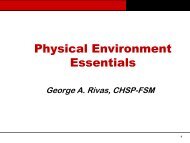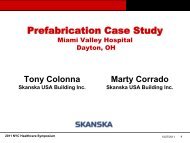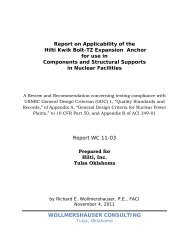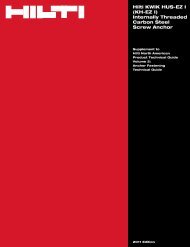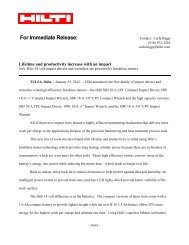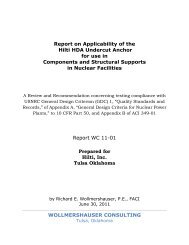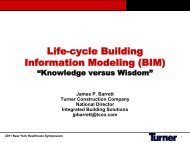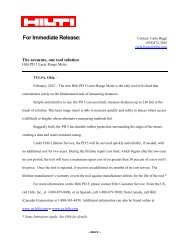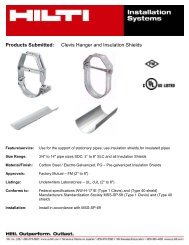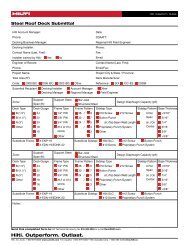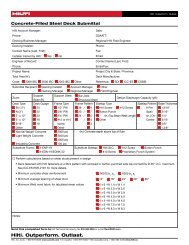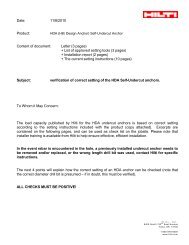Types of Anchors for Anchoring to Concrete - Hilti
Types of Anchors for Anchoring to Concrete - Hilti
Types of Anchors for Anchoring to Concrete - Hilti
You also want an ePaper? Increase the reach of your titles
YUMPU automatically turns print PDFs into web optimized ePapers that Google loves.
1.5<br />
Traditionally, design<br />
engineers specify<br />
cast-in-place anchors if<br />
they know be<strong>for</strong>ehand<br />
where anchors are <strong>to</strong><br />
be installed.<br />
Headed Bolt L-Bolt J-Bolt Stud-welded Plate<br />
FIGURE 2. Cast-in-place <strong>Anchors</strong><br />
Many <strong>of</strong> these types <strong>of</strong> anchors have<br />
special uses. Shear lugs and stud-welded<br />
plates provide large shear resistance,<br />
while channel bars give specific attachment<br />
capability. J and L bolts are typically<br />
used <strong>for</strong> anchoring sill plates <strong>to</strong><br />
foundations, but have a tendency <strong>to</strong><br />
straighten and pull out under high tension<br />
loading. Headed bolts under<br />
ASTM A 490 and F 1554 specifications<br />
are veritable workhorses <strong>for</strong> structural<br />
engineers.<br />
But what if the cast-in-place anchor is<br />
mislocated, or if the location <strong>of</strong> the<br />
anchor is not known be<strong>for</strong>e construction,<br />
or additional anchorages need <strong>to</strong><br />
be made after the concrete is cast? The<br />
post-installed anchor industry has developed<br />
a wide variety <strong>of</strong> products <strong>for</strong> these<br />
situations.<br />
POST-INSTALLED ANCHORS<br />
With the development and improvements<br />
<strong>of</strong> rotary hammer drills and carbide-tipped<br />
bits, the user has the<br />
capability <strong>to</strong> install many different kinds<br />
<strong>of</strong> post-installed anchors in hardened<br />
concrete virtually anywhere that is accessible<br />
<strong>to</strong> the drills.<br />
Post-installed anchors can be divided<br />
in<strong>to</strong> two major types, depending on the<br />
method <strong>of</strong> transferring load in<strong>to</strong> the<br />
concrete. They are mechanical systems<br />
and bonded or adhesive systems.<br />
<strong>Anchors</strong> can also be cross-classified<br />
according <strong>to</strong> their load carrying capability;<br />
heavy-duty, medium-duty and lightduty.<br />
Table 2 provides an overview <strong>of</strong> the<br />
major types <strong>of</strong> post-installed anchors currently<br />
available as well as a generalized<br />
load categorization.<br />
Table 2. Post-Installed <strong>Anchors</strong><br />
MECHANICAL SYSTEMS HEAVY- MEDIUM- LIGHT-<br />
DUTY DUTY DUTY<br />
Undercut <strong>Anchors</strong><br />
•<br />
Torque-controlled expansion anchors<br />
Heavy duty sleeve anchor • •<br />
Wedge anchors • • x<br />
Coil anchors • • x<br />
Screw anchors • • •<br />
Sleeve anchors • •<br />
Light duty metal anchors<br />
•<br />
Plastic anchors<br />
•<br />
Displacement-controlled expansion anchors<br />
Drop-in x • x<br />
Self-drilling x • x<br />
BONDED OR ADHESIVE SYSTEMS<br />
Using threaded rods or rein<strong>for</strong>cing bars<br />
Capsule systems • • x<br />
Cartridge systems • • x<br />
Bulk-injection systems • • x<br />
Cemetitious or epoxy grouted systems • • x<br />
• Indicates normal category<br />
x Indicates possible but not primary category<br />
MECHANICAL<br />
ANCHORING SYSTEMS<br />
While mechanical anchors have been<br />
available <strong>for</strong> several decades, there have<br />
been significant advances in the types<br />
and capabilities <strong>of</strong> these systems. They<br />
cover the range from heavy duty <strong>to</strong> light<br />
duty capacities. The major concern is <strong>to</strong><br />
select the appropriate anchors that will<br />
resist the expected loads <strong>for</strong> the given<br />
application. Is the anchor expected <strong>to</strong><br />
experience seismic or fatigue loads, or<br />
merely static loads? While some anchors<br />
will withstand all <strong>of</strong> these types <strong>of</strong> loads,<br />
others may fail abruptly under dynamic<br />
loading at a load level less than the static<br />
capacity.<br />
■ UNDERCUT ANCHORS<br />
These anchors have been on the market<br />
<strong>for</strong> about 20 years. They are excellent<br />
<strong>for</strong> use under both static and<br />
dynamic loads. They obtain their holding<br />
capacity through keying, that is,<br />
direct bearing on the concrete, and,<br />
under proper installation, can withstand<br />
very high loads without slipping out <strong>of</strong><br />
the drilled hole. They are the preferred<br />
anchors <strong>for</strong> use where cracks in tension<br />
zones <strong>of</strong> the concrete can be expected <strong>to</strong><br />
occur.



